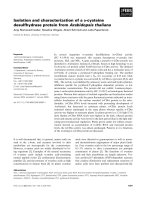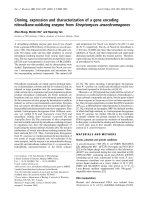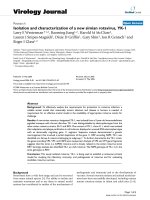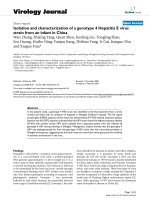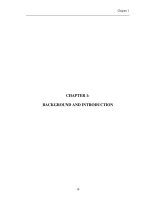Isolation and characterization of a promising plant growth promoting Rhizobacterium from Trichosanthes dioica Roxb. rhizosphere
Bạn đang xem bản rút gọn của tài liệu. Xem và tải ngay bản đầy đủ của tài liệu tại đây (377.76 KB, 8 trang )
Int.J.Curr.Microbiol.App.Sci (2017) 6(4): 544-551
International Journal of Current Microbiology and Applied Sciences
ISSN: 2319-7706 Volume 6 Number 4 (2017) pp. 544-551
Journal homepage:
Original Research Article
/>
Isolation and Characterization of a Promising Plant Growth Promoting
Rhizobacterium from Trichosanthes dioica Roxb. Rhizosphere
Satinath Das and Narayan C. Mandal*
Mycology and Plant Pathology Laboratory, Department of Botany, Visva-Bharati,
Santiniketan 731235, West Bengal, India
*Corresponding author
ABSTRACT
Keywords
PGPR, Anti fungal,
Scanning electron
microscopy,
Burkholderia.
Article Info
Accepted:
06 March 2017
Available Online:
10 April 2017
A total number of 10 rhizosperic bacteria were isolated from root environment of some
healthy plants of a drastic diseased field with massive blighted symptoms of Trichosanthes
dioica of Akilpur of Hooghly district, West Bengal (22.94º E 88.12º N) where soil is
alluvial in nature. Among the isolates, one strain TR9 showed remarkable plant growth
promoting activity. Cell free culture filtrate of TR9 produced clear zones of inhibition
(diameter ranging from 1.67cm to 2.67cm) against different plant pathogenic fungi viz.
Colletotrichum acutatum, Alternaria alternata and Helminthosporium compactum. It is
quite capable of lowering the pH of its environment and also can solubilise insoluble
phosphate sources. Siderophore production by this strain gives a positive result.
Biochemical characterization indicated the ability of the strain to utilize a broad range of
carbon sources, catalase positivity and also to reduce the nitrate and nitrite. It is highly
sensitive to 4-quinolone derivative antibiotics viz. ciprofloxacin, norfloxacin and resistant
to beta lactams like ampicilin, cephalothin, cephalexin. Light compound microscopy
showed it to be a Gram negative rod shaped one which was re established by scanning
electron microscopy. All these characteristic features indicate the strain to be a species of
Burkholderia.
Introduction
Plants-microbes relationship is a common but
important
phenomenon.
Diverse
microorganisms, varying from pathogens to
beneficial, continuously interact with higher
plants in soil ecosystem and influence the
development of plant growth in the soil
(Ahmad et al., 2008; Taghavi et al., 2009). In
the rhizosphere of crop plants it is crucial in
contributing
protection
as
well
as
supplementation of nutrients to the crop
plants by their microbial associates. Among
the different plant growth promoting
characters, ability to solubilize insoluble
phosphatic materials in the soil, production of
siderophore for iron chelation, ability to kill
pathogens to crop plants makes a rhizospheric
bacterial strain more potent PGPR. Efficient
insoluble
phosphate
solubilizing
microorganisms have been isolated from
various rhizosphere with PGP activity (Ghosh
et al., 2016; Rodriguez and Fraga, 1999).
Exploration by characterizing all those PGP
activities may lead to find a promising PGPR
strain for field application. As phytopathogens reduce crop productivity at various
extents, control of such pathogens become
544
Int.J.Curr.Microbiol.App.Sci (2017) 6(4): 544-551
necessary. Proper and tricky use of these
rhizospheric bacteria can be a sharp wing of
biological control. Many rhizobacteria are
proven to be useful in inhibiting plant
pathogens efficiently (Plant Pathology,
Agrios, 2005; Ghosh et al., 2015; Ghosh et
al., 2016). In our present endeavor we also
wanted to isolate a potent PGPR strain from
alluvial soil zone of lower Gangetic plain,
where the soil is highly active because of elite
agricultural
practice
and
phosphate
requirement in the soil is in highest demand.
acutatum MTCC2074, Alternaria alternata
VBAV007
and
Helminthosporium
compactum MTCC351 using cell free
supernatant of TR9 by agar well diffusion
(Fernández et al., 1992) method and dual
culture over lay method (Magnusson and
Schnürer, 2001).
Agar well diffusion method: The rhizospheric
strain TR9 was cultured in nutrient broth at
28±2 ˚C and aliquots were collected at every
24hrs interval for five days. The aliquots were
centrifuged to collect the supernatants, 50 µl
of which was further used in the wells on malt
agar plates seeded with three fungal spores.
The plates were incubated for next 72-96hrs
and observed.
Materials and Methods
Isolation of the organism
Rhizospheric soil of a very healthy
Trichosanthes dioica plant from a heavily
diseased field with massive blighted
symptoms was collected from Akilpur of
Hooghly district, West Bengal, India. The soil
sample was quickly brought to laboratory.
One gram of soil was mixed in 10 ml of
sterile distilled water very well to make a
suspension. Different dilutions of the soil
suspension were spread on Pikovskaya agar
medium containing in soluble tri calcium
phosphate as sole phosphate source. Plates
were incubated at 28±2˚C for 72-96 hrs for
the growth of the soil microbes. The
composition of Pikovskaya agar medium was
like (gm/L): dextrose 10; Ca3PO4 5;
(NH4)2SO4 0.5; NaCl 0.2; MgSO4 0.1; KCl
0.2; yeast extract 0.5; MnSO4, 7H2O 0.002;
FeSO4, 7H2O 0.002; agar agar 20, H2O 1000
ml; pH 7.0±0.2. Bacterial colonies, forming
clear solubilizing appearance round it on
insoluble phosphate containing Pikovskaya
agar plate, were selected, purified and
maintained for further studies.
Dual culture overlay method: The bacterial
strain was streaked on sterile nutrient agar
medium plates and were allowed to grow for
24 hrs at 28 ±2 ˚C. Seven ml of malt extract
soft agar (0.7% agar) medium containing
100µl of fungal mycelia culture were overlaid
on the plates. Plates were further incubated
for next 72-96 hrs at the same incubation
condition.
Phosphate solubilization
TR9 was screened upon creation of prominent
clear solubilizing zone on Pikovskaya agar
plate. The quantitative assay of phosphate
solubilization
was
performed
using
Pikovskaya broth with insoluble tri calcium
phosphate as sole phosphate source. TR9 was
inoculated to 100 ml sterile Pikovskaya broth
with 0.5% tri calcium phosphate (w/v) at
28±2˚C with mild shaking condition (100rpm)
for 120 hrs. After regular interval of 24hrs
daily aliquots were collected. Uninoculated
Pikovskaya broth was treated as control. The
amount of soluble phosphate was measured
by the method of Chen (Chen et al., 1956)
after centrifuging the culture filtrate at 10000
rpm for 10 minutes. The experiment was
performed in three sets separately.
Antifungal studies
Antifungal activity of the selected strain TR9
strain was evaluated against three plant
pathogenic
fungi
viz.
Colletotrichum
545
Int.J.Curr.Microbiol.App.Sci (2017) 6(4): 544-551
bacteria was inoculated into this broth and
observed after incubation of 32±2˚C for 1824hrs.
Measurement of pH
The pH of the cultures was measured at
different days of incubation in Pikovskya
broth containing insoluble phosphate with the
help of a digital pH meter (Systronics Digital
pH meter 802). The experiment was
performed with a triplet set.
Antibiotic sensitivity assay
Antibiotic sensitivity assay was performed
using Himedia Octodiscs. From a freshly
cultured medium, 100 µl was taken and
evenly spread over nutrient agar plates. Each
of the seven octodiscs holding different
antibiotics at different concentrations was
placed on the plates. It was incubated at
28±2˚C for 24hrs.
Siderophore production assay
The qualitative test for production of
siderophore by TR9 was performed on CAS
(Chrome Azurol S) agar plate (Ames-Gottfred
et al., 1989). Sterile CAS agar plates were
prepared following protocol. The bacterial
strain was streaked on the plates and
incubated for 24-48 hrs at 28±2˚C to check if
there is any orange coloration.
Scanning electron microscopic study
Morphology study was performed via
scanning electron microscopy. The specimen
was prepared as follows: overnight cultured
cells were harvested by centrifugation at
10000 rpm for 10 minutes. Bacterial cell
pellets were collected and washed twice
saline and prefixed with a mixture of 3%
gluteraldehyde and 5% DMSO in 0.05 M
acetate buffer, pH 5.0, for 30 minutes. After
centrifuging at 10000 rpm for 10 minutes cell
pellets were harvested and washed twice with
0.1M sodium acetate buffer, pH 5. Cells were
collected centrifuging at 10000 rpm for 10
minutes and applied over a thin slide, heat
fixed and were dehydrated through a series of
ethyl alcohol starting with 30% through 40,
50, 60, 70, 80, 90, 95% and finally with 100%
with 10 minutes of dehydration in each grade
(Mandal et al., 2013). Slide was mounted on
stab and gold coated (Coater IB-2, Gike
Engineering, Japan) before observing in
microscope (HITACHI S-530, Japan).
Biochemical tests
Carbohydrate utilization test
Carbohydrate utilization test was performed
with HiCarboTM kit (KB009A /KB009B1 /
KB009C). TR9 was inoculated in nutrient
broth and incubated overnight and checked
the OD at 620 nm if it was more than 0.5.
Uninoculated nutrient broth was set as control
one. Culture with OD ≥ 0.5 was taken and
inoculated 50µl in each well of the kit. The kit
(Part a, Part B and Part C) were incubated at
30±2˚C for 18-24 hrs.
Catalase test
Catalase test was performed to take some
amount of freshly cultured colonies on a clean
dry glass slide with the help of a loop 1-2
drops of 3% H2O2 was added to it and
checked if any bubble formation occurred.
Results and Discussion
Nitrate reduction test
Isolation of a potent phosphate solubilizing
bacteria
Nitrate reduction test was done using ready
prepared nitrate broth from HiMedia. The
There is a vast possibility to have some plant
growth supporting agent from a healthy plant
546
Int.J.Curr.Microbiol.App.Sci (2017) 6(4): 544-551
of a diseased field. Thus ten phosphate
solubilizing bacteria were isolated from such
a healthy Trichosanthes dioica rhizospheric
soil. Among those isolates, one strain, TR9
was selected for further studies considering its
remarkable phosphate solubilizing ability
(Fig. 1).
responded positively to nitrate and catalase
tests. TR9 can utilize dextrose, maltose,
fructose, mannose and showed positive
response for esculin hydrolysis, citrate
utilization and malonate utilization (Table 1).
The strain was resistant to beta lactum
antibiotics like ampicilin, cephalothin,
cephalexin but sensitive to tetracycline,
kanamycin, streptomycin, chloramphenicol,
norfloxacin,
gentamycin,
tobramycin,
trimethoprim and others (Table 2). Based on
the different biochemical and morphological
characteristics and matching the data obtained
with Bergeys’ Manual of Systematic
Bacteriology (Vermis et al., 2002) the strain
was preliminary identified to be a member of
the genus Burkholderia.
Characterization of the isolated strain
The strain was characterized based on
morphological and biochemical parameters.
For morphological characterization Gram
staining and SEM study was done. Gram
staining revealed the strain to be Gram
negative rod shaped which was supported by
the SEM study (Fig. 2) also. The strain
Table.1 Different carbohydrate utilization by TR9
Carbohydrates
Lactose
Xylose
Maltose
Fructose
Galactose
Dextrose
Sucrose
ONPG
Utilization by TR9
+
+
+
+
+
+
+
_
Carbohydrates
L-Arabinose
Mannose
Rhamnose
Cellobiose
Sorbitol
Citrate utilization
Malonate utilization
Esculin hydrolysis
‘+’ indicates utilized, ‘-’ not utilized
Figure.1 Phosphate solubilization by TR9
547
Utilization by TR9
+
+
+
+
+
+
+
Int.J.Curr.Microbiol.App.Sci (2017) 6(4): 544-551
Table.2 Antibiotic sensitivity profile of TR9
Antimicrobial
agent
Sensitivity
Antimicrobial
agent
Sensitivity
Antimicrobial
agent
Tetraclycine
Amikacin
Sensitive
Sensitive
Gentamycin
Norfloxacin
Sensitive
Sensitive
Penicillin-G
Ampicilin
Resistant
Resistant
Carbenicilin
Ciprofloxacin
Sensitive
Sensitive
Tobramycin
Clindamycin
Sensitive
Resistant
Cephalothin
Colistin
Resistant
Resistant
Co-Trimazine
Kanamycin
Sensitive
Sensitive
Vancomycin
Cloxacilin
Sensitive
Resistant
Sulphatriad
Ticarcilin
Sensitive
Sensitive
Nitrofurantoin
Streptomycin
Resistant
Resistant
Cefaloridine
Linkomycin
Sensitive
Resistant
Cefalexin
Erythromycin
Resistant
Resistant
Chloramphenicol
Sulphamethoxazole
Sensitive
Resistant
Methicilin
Oleadomycin
Resistant
Sensitive
Oxacilin
Amoxicilin
Sensitive
Resistant
Table.3 Anti fungal activity of TR9 by dual culture overlay method
Plant pathogenic
fungal strains
Colletotrichum
acutatum MTCC2074
Alternaria alternata
VBAV007
Helminthosporium
compactum MTCC351
Diameter of zones of inhibition (cm)
Day Day 2 Day 3 Day 4 Day 5
1
1.27 1.38
1.7
1.96
2.67
1.58
1.6
1.62
1.66
1.67
1.9
1.97
1.98
2.0
2.47
Figure.2 Scanning electron micrograph of TR9
548
Sensitivity
Int.J.Curr.Microbiol.App.Sci (2017) 6(4): 544-551
Figure.3 Antifungal activity of TR9 by dual culture overlay method against A) Colletotrichum
acutatum MTCC2074 B) Alternaria alternata VBAV007
Figure.4 Phosphate solubilizing kinetics with pH drops by TR9
Figure.5 Siderophore production by TR9
549
Int.J.Curr.Microbiol.App.Sci (2017) 6(4): 544-551
due to the production of organic acids like
gluconic and 2-ketogluconic acids which
chelates the metal cations from insoluble
phosphates (Khan et al., 2009). This supports
the gradual decrease of pH. Formation of a
clear bright orange coloration on blue CAS
agar plate surrounding the growth of the
bacteria indicates the ability of siderophore
production by the strain (Fig. 5). As
availability of ferric iron is crucial to proper
functioning of the terminal oxidation pathway
and ultimately the efficiency of the
rhizobacteria, siderophore production by the
selected strain TR9 thus makes it an efficient
one.
Antifungal activity of the strain
TR9 showed a clear antagonistic activity
against Colletotrichum acutatum, Alternaria
alternata and Helminthosporium compactum
when tested via dual culture overlay method
(Fig. 3) against different plant pathogenic
fungi. It produced a very clear zone of
inhibition suppressing the fungal growth
surrounding it. The results obtained are very
promising in terms of biological control of
phytopathogens. In agar well diffusion
method increasing of diameter of zones of
inhibition found with 5th day of culture
filtrate.
Maximum inhibition was found in case of
Helminthosporium compactum when it was
treated with 5th day culture of TR9 where the
diameter of zone of inhibition was 2.67 cm.
On the other hand least inhibition by the
strain was found for 5th day CFS against
Alternaria alternata which was1.66cm. Day
wise antifungal data is tabulated in table 3. It
is previously reported that Burkholderia
cenocepacia can successfully control the leaf
spot of Aloe vera caused by Alternaria
alternata (Ghosh et al., 2016)and also can
reduce the incidence of fruit rot of jackfruit
by Rhizopus stolonifer (Ghosh et al., 2015).
Not only from the view of PGP activities,
TR9 can be helpful in disease control too.
In conclusion microbiology and agriculture
are very tightly connected to each other. From
the root tip to the top of shoot or from the
view of pathogen to bio-control agent
presence of microbes flash everywhere.
Having some bacterial strain with different
anti pathogenic property and plant growth
promoting activity is a good sign from
beneficial aspects. The strain TR9 which has
been isolated from the Trichosanthes dioica
rhizosphere has shown both nutrient
mobilizing property as well as pathogen
killing property which can be prospective biofertilizer inoculums in agricultural application
after designing proper formulation.
Acknowledgements
Kinetics of phosphate solubilization and
siderophore production
SD is thankful to UGC for providing BSR
fellowship
The strain is quite capable to solubilize
insoluble phosphate of Pikovskaya broth
containing insoluble tricalcium phosphate and
produced 327 μg/ml soluble P at 5th day of
incubation while pH of the culture drops to
4.41. A rapid increase of amount soluble
phosphate was found in between 24 to 48 hrs
which is 85 µg/ml to 245µg/ml and it is also
reflected in lowering the pH from 5.6 to 4.75
(Fig. 4). Solubilization of phosphate may be
References
Agrios, G.N. 2005. Plant Pathol., (Elsevier,
Academic Press) Fifth Edition.
Ahmad, F., Ahmad, I., and Khan, M.S. 2008.
Screening of free-living rhizosphere
bacteria for their multiple plant growth
promoting activities, Microbiol. Res., 163:
173–181.
Ames-Gottfred, N.P., Christie, B.R., and Jordan,
550
Int.J.Curr.Microbiol.App.Sci (2017) 6(4): 544-551
D.C. 1989. Use of the Chrome Azurol S
agar plate technique to differentiate strains
and
field
isolates
of
Rhizobium
leguminosarum biovar trifolii. Appl.
Environ. Microbiol., 55(3): 707–710.
Chen, P.S., Tonbara, T.Y., and Warner, H. 1956.
Micro determination of phosphorus. Anal.
Chem., 28: 1756–1758.
Fernández –Garayzábal, J.F., Delgado, C.,
Blanco, M., Vázquez-Boland, J.A., Briones,
V., Suárez, G., Domínguez, L. 1999. Role
of potassium tellurite and brain heart
infusion in expression of the haemolytic
phenotype of Listeria spp. on agar plates.
Appl. Environ. Microbiol., 58: 434-438.
Ghosh, R., Barman, S., Khatun, J., and Mandal,
N.C. 2016. Biological control of Alternaria
alternata causing leaf spot disease of Aloe
vera using two strains of rhizobacteria.
Biol. Control, 97: 102-108.
Ghosh, R., Barman, S., Mukherjee, R., and
Mandal, N.C. 2016. Role of phosphate
solubilizing
Burkholderia
spp.
for
successful colonization and growth
promotion of Lycopodium cernuum
L.(Lycopodiaceae) in lateritic belt of
Birbhum district of West Bengal, India.
Microbiol. Res., 183: 80-91.
Ghosh, R., Barman, S., Mukhopadhyay, A., and
Mandal, N.C. 2015. Biological control of
fruit-rot of jackfruit by rhizobacteria and
food grade lactic acid bacteria. Biol.
Control, 83: 29-36
Khan, A.K., Jilani, G., Akhtar, M.S., Naqvi,
S.M.S. and Rasheed, M. 2009. Phosphorus
solubilizing
bacteria:
occurrence,
mechanisms and their role in crop
production. J. Agric. Biol. Sci., 1(1): 48–58.
Magnusson, J., and Schnürer, J. 2001.
Lactobacillus
coryniformis
subsp.
Coryniformis strain SI3 produces a broadspectrum
proteinaceous
antifungal
compound. Appl. Environ. Microbiol., 67:
1–5.
Mandal, V., Sen, S.K., and Mandal, N.C. 2013.
Production and partial characterization of
an inducer dependent novel antifungal
compound(s) by Pediococcus acidilactici
LAB5. J. Sci. Food Agric., 93: 2445–2453.
Rodriguez, H., and Fraga, R. 1999. Phosphate
solubilizing bacteria and their role in plant
growth promotion, Biotechnol. Adv., 17:
319-339.
Taghavi, S., Garafola, C., Monchy. S., Newman,
L., Hoffman, A., Weyens, N., Barac, T.,
Vangronsveld, J., and van der Lelie, D.
2009. Genome survey and characterization
of endophytic bacteria exhibiting a
beneficial
effect
on
growth
and
development of poplar trees, Appl. Environ.
Microbiol., 75: 748–757.
Vermis, K., Coenye, T., Mahenthiralingam, E.,
Nelis, J.H. and Vandamme, P. 2002.
Evaluation of species specific recA-based
PCR
tests
for
genomover
level
identification within the Burkholderia
cenocepacia complex. J. Med. Microbiol.,
51: 937-940.
How to cite this article:
Satinath Das and Narayan C. Mandal. 2017. Isolation and Characterization of a Promising Plant Growth
Promoting
Rhizobacterium
from
Trichosanthes
dioica
Roxb.
Rhizosphere.
Int.J.Curr.Microbiol.App.Sci. 6(4): 544-551. doi: />
551



